- Home
- Encyclopedia
- New Perspectives On The Fetterman Fight
New Perspectives on the Fetterman Fight
As the Civil War drew to a close, the U. S. Army was called upon to protect civilians traveling on the Bozeman Trail to gold mines in Montana Territory from a growing number of so-called hostile American Indians led by Red Cloud. Grossly underestimating the strength and determination of the Indian forces, the army sent Col. Henry B. Carrington, a lawyer who spent the Civil War far removed from battle, in command of the partially recruited 18th Infantry Regiment to guard the trail.
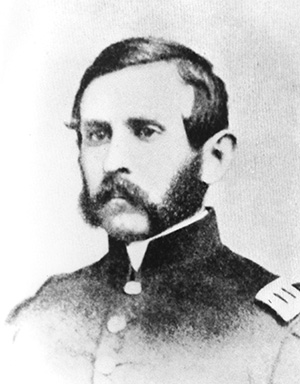
In the spring of 1866, General William T. Sherman, commander of the region, met with Carrington before his expedition departed and encouraged officers to take their wives and families along, assuring them “a pleasant garrison life in the newly opened country, where all would be healthful, with pleasant service and absolute peace.”
By mid-July 1866 Carrington had established three posts on the Bozeman Trail, with headquarters at Fort Phil Kearny on the east flank of the Bighorn Mountains near present Story, Wyo., about 230 miles northwest of Fort Laramie. While the troops went about cutting wood and building their fort, Red Cloud’s followers gathered a few miles north of the post in a camp of as many as 2,000 warriors and their families—larger than the city of Omaha at the time.
The Indians harassed the fort at every opportunity. The civilian contractors who cut the fort’s lumber in a pine stand a few miles west were a prime target and required a military escort at all times. By mid-December, nearly 70 soldiers and civilians had been killed in over 50 skirmishes practically within view of the post; Sherman’s “pleasant service and absolute peace” had become what is now known as Red Cloud’s War.
Capt. William Judd Fetterman arrived at Fort Phil Kearny on Nov. 3, 1866, as the Indian attacks were peaking. Seven weeks later, on Dec. 21, 1866, Fetterman and 79 soldiers and civilians were killed in a lopsided battle that was soon mythologized as the Fetterman Massacre. For over a century, the legend of this battle was shaped by two women who accompanied the soldiers to the fort—the first and second wives of Colonel Carrington, both of whom wrote books that were published in an attempt to exonerate their husband from accusations that his inept leadership was the underlying cause of the catastrophe.
Much has been written about the atmosphere at the fort being rife with insubordination toward Carrington because he was not taking offensive measures, but by the time Fetterman arrived, the officers were well aware of the military superiority of the Indians and appreciated the precariousness of their situation. Carrington even authorized Fetterman to attempt a few offensive tactics during his first days at the post, but within a few weeks Fetterman had been involved in a half-dozen deadly skirmishes, and he acknowledged, “This Indian war has become a hand-to-hand fight, requiring the utmost caution.” Yet the story that evolved portrays Fetterman as openly contemptuous of Carrington and desperate to prove his superiority in battle, proclaiming “give me 80 men and I can ride through the whole Sioux Nation.”
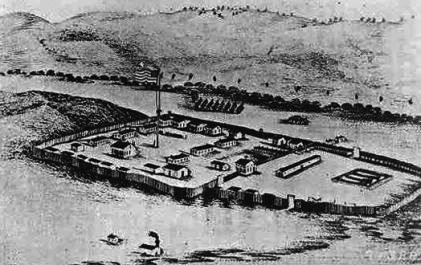
This characterization is contradicted by a great deal of evidence documenting Fetterman’s military acumen and his personal and professional demeanor. Although his father and uncle were both West Point graduates, he was not accepted when he applied in 1853 at the age of 18. Fetterman reluctantly turned to a career in business until the outbreak of the Civil War gave him a second chance for a military life and he enlisted in Carrington’s regiment as a 27-year-old officer.
During the early days of the war Fetterman worked quite closely with Carrington in Ohio and impressed his colonel as being ambitious and proficient. Later, Margaret Carrington, writing to protect her husband's reputation at the expense of Fetterman's, would nevertheless write that Fetterman during his service in Ohio “commanded esteem by his refinement, gentlemanly manners, and adaptation to social life.”
Through the rest of the Civil War Fetterman served with distinction, rising through the ranks to acting assistant adjutant general of nine regiments—more than ten thousand men—and was ultimately brevetted lieutenant colonel for “great gallantry and good conduct.”
Four years of increasing responsibility shaped Fetterman into a seasoned and well-respected military officer. The army reorganization that was scheduled to go into effect on Jan. 1, 1867, would have Fetterman assuming command of a newly formed 27th Infantry Regiment based at Fort Phil Kearny and would move Carrington and his 18th Infantry Regiment to a fort farther south on the Bozeman Trail. Claiming Fetterman was desperate to prove his superiority in battle belies the fact that he did not need to prove it to anyone.
On the day of the disaster, Fetterman is said to have insisted “by his rank” on taking command of the detail going out to relieve a party of woodcutters who were under attack—a fact frequently cited to demonstrate Fetterman was desperate to fight. Carrington claimed he reluctantly gave Fetterman the assignment, but was so concerned about the officer’s overzealous nature that he gave explicit, detailed orders that under no circumstance was Fetterman to cross Lodge Trail Ridge in pursuit of Indians. Today we know that the evidence supporting these two claims by Carrington is countered by more evidence and testimony to the contrary.
Witnesses were uncharacteristically unanimous that Fetterman did not proceed west to the wood train per Carrington’s supposed orders—he went northeast directly toward the southern end of Lodge Trail Ridge. Carrington even wrote in his official report that Fetterman was “evidently moving wisely up the creek and along the southern slope on Lodge Trail Ridge, with good promise of cutting off the Indians.” Coupled with the fact that this was the largest “relief” force ever sent out by Carrington, it is quite possible that Carrington and Fetterman had planned this as an offensive action—though Fetterman was fully aware that he was in a vulnerable position.
Fetterman was leading a detachment of raw recruits on foot, only the second time soldiers had marched to relieve a wood train under attack. Months of Indian raids on the army horse herd, inconsistent delivery of grain and the necessity of using horses on the trails for escort and mail duty left just three dozen serviceable army horses at the fort. Plus, most of his soldiers were newly enlisted and had little experience with weapons or military tactics. Shortly after he arrived, Fetterman realized his men—who had spent the past four months as a construction crew—were not prepared for combat and he began drilling them on infantry maneuvers.
After Fetterman quickly inspected his men and marched out of the fort, Lt. George W. Grummond requested permission to lead a small cavalry detail to support the infantry detachment. Carrington approved the request but very publicly ordered Grummond to report to Fetterman and “implicitly obey orders, and not leave him.” Carrington had good reason to be concerned about Grummond, whose military record included recklessness in battle, insubordination and a series of violent, drunken incidents culminating in being court-martialed and publicly reprimanded.
Two weeks earlier, on December 6, Carrington and Fetterman led an offensive where Grummond had disobeyed Carrington’s direct orders and led four soldiers directly into a trap that cost two of the men their lives—clearly inspiring the ambush tactic that the Indians would execute so well on December 21. It is a testament to Carrington’s desperate shortage of officers that he approved Grummond’s request to support Fetterman’s command.
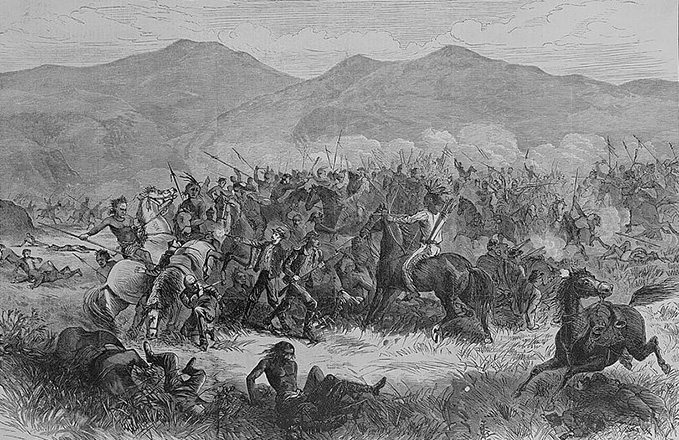
Grummond and 27 cavalrymen caught up to the infantry about a half-mile out. The contingent was soon joined by the post quartermaster, Capt. Fred Brown, and two of his civilian employees, James Wheatley and Isaac Fisher. Fetterman’s command was exactly 80 men—a striking coincidence with the number of men with which he supposedly claimed he could ride through the whole Sioux Nation. The force was in pursuit of a group of Indians, including the Lakota warrior, Crazy Horse, lingering around the crest of Lodge Trail Ridge acting as decoys to lure the soldiers into a trap.
Coupled with what we now know about Grummond’s rash and insubordinate background in battle it seems clear that the mounted men, led by Grummond, raced out more than a mile ahead of the infantry in pursuit of Crazy Horse and other Indians—well beyond the crest of Lodge Trail Ridge.
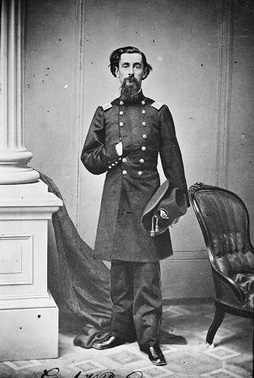
J. W. Vaughn’s masterful analysis of the battle site, published in 1966, proved it would have been impossible for Fetterman, with his marching infantrymen, in the time that elapsed, to cover the distance between the fort and the spot a mile and a half beyond the ridge where the mounted soldiers were first attacked. Oral evidence from Indian participants substantiates this assertion.
We will never know what went through Fetterman’s mind as he stood looking north from the crest of Lodge Trail Ridge, but it is highly likely that the reason he went beyond it and out of sight of the fort was to attempt to support the men on horseback—not because he was irrationally desperate for glory.
Once Fetterman and the infantry were beyond the ridge and inside the trap, they were quickly overwhelmed. In what they called the Battle of the Hundred in the Hand, the Lakota, Northern Cheyenne and Northern Arapaho executed a plan they had been developing for weeks. The Indians incurred extensive friendly-fire casualties as they shot arrows from both sides of the sprung trap and hundreds simply watched the battle from the adjacent hillsides.
In retaliation for atrocities visited upon Arapaho and Cheyenne families in the Sand Creek Massacre two years earlier, the dead soldiers were stripped and mutilated. The Indians did not spend a lot of time in the area, however. As soon as Carrington at the fort heard the gunfire, he sent a detachment under Capt. Tenodor Ten Eyck, and when taunts could not lure the soldiers to come down to the battle site, the Indians left the field.
Assuming the soldiers had their mountain howitzer with them, the Indians quickly retreated to their camps to treat the injured and mourn their dead. Ten Eyck’s group was only able to bring back about half of the bodies of the fallen soldiers. The next day, under dark clouds portending the blizzard that would isolate the fort for several weeks, Carrington and a small group of brave volunteers went to the field and brought back the remaining frozen corpses to prepare for burial.
For the next 40 years, Carrington sought to clear his name from the blame that almost immediately began to be pointed in his direction. The army needed a scapegoat, and Carrington fit the bill. In 1868 his wife, Margaret, published Absaraka, Home of the Crows: Being the Experience of an Officer's Wife on the Plains, as a vehicle to tell her beleaguered husband’s side of the story. After Margaret died in 1870, Carrington wed Frances Grummond, the widow of George Grummond, the lieutenant whose rash judgment may have been the real cause of the disaster. In 1910 Frances Grummond Carrington published her own account of the incident in My Army Life and the Fort Phil Kearney Massacre: With an Account of the Celebration of "Wyoming Opened," also to defend her husband’s reputation 40 years after the fact.
Both books, which for the next century were the primary sources used to tell the story of this battle, claim Fetterman was desperate for glory and ignorant of the superiority of his Indian adversaries, saying he could ride through the whole Sioux Nation with 80 men. Today, historians are revisiting the story and updating the characterization of Fetterman that was derived from this flawed history. The story of the Fetterman Fight is far more complex and nuanced than the simple narrative that has persisted all these years.
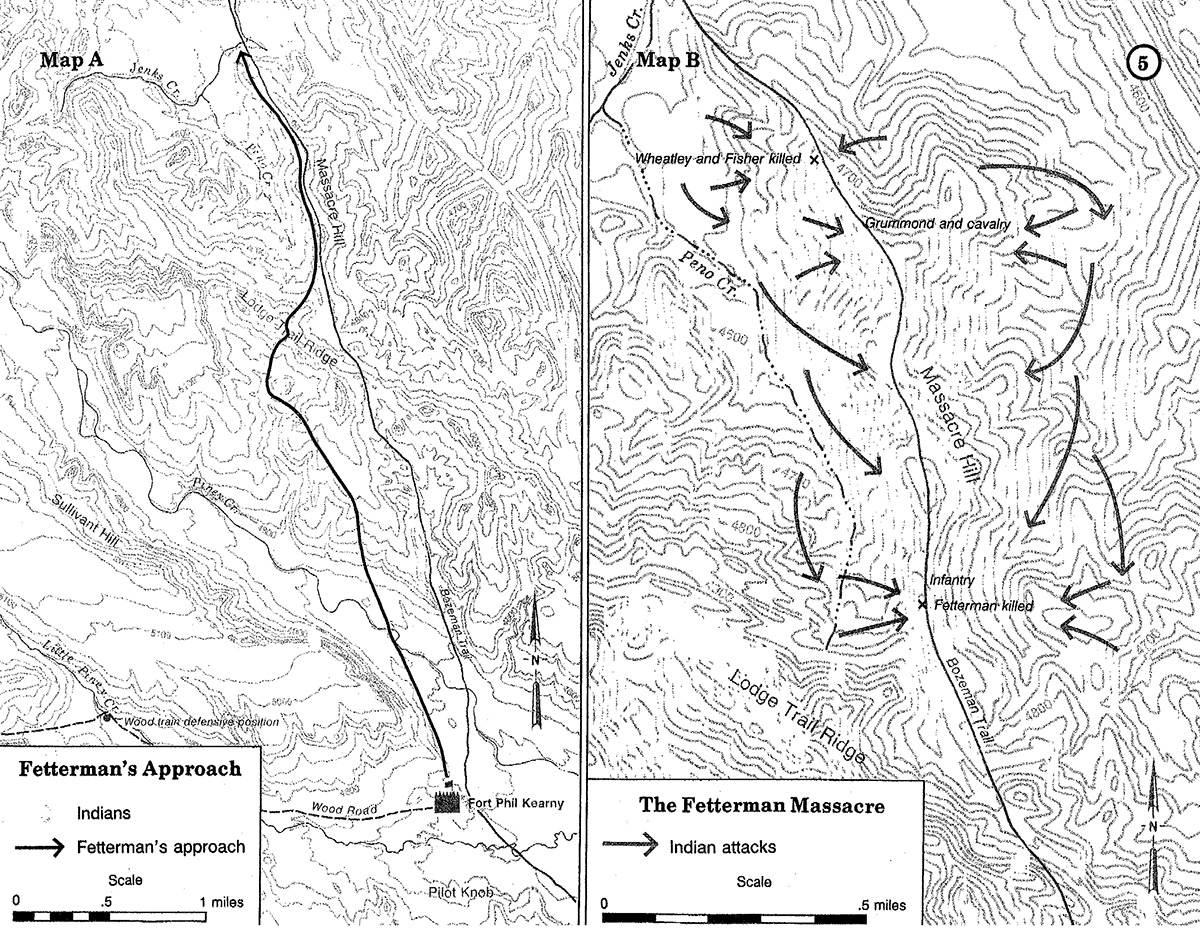
Resources
Primary Sources
- Carrington, Margaret I. Absaraka, Home of the Crows. Philadelphia: J.B. Lippincott, 1868. Reprint, Lincoln: University of Nebraska Press, Bison Books, 1983.
- Carrington, Frances C. My Army Life and the Fort Phil. Kearney Massacre with An Account of the Celebration of “Wyoming Opened.” Philadelphia: J.B. Lippincott, 1910. Reprint: Lincoln: University of Nebraska Press, Bison Books, 2004.
Secondary Sources
- McGinnis, Anthony. “Strike and Retreat: Intertribal Warfare and the Powder River War, 1865-1868,” Montana: the Magazine of Western History, Autumn 1980, 30-41.
- Monnett, John H. Where a Hundred Soldiers Were Killed: The Struggle for the Powder River Country in 1866 and the Making of the Fetterman Myth. Albuquerque: University of New Mexico Press, 2010.
- Murray, Robert A. Military Posts in the Powder River Country of Wyoming, 1865-1894. Lincoln: University of Nebraska Press, 1968.
- Smith, Shannon D. “Give Me Eighty Men”: Women and the Myth of the Fetterman Fight. Lincoln: University of Nebraska Press, 2009. Reprint: Lincoln: University of Nebraska Press, Bison Books, 2010.
- Vaughn, J.W. Indian Fights: New Facts on Seven Encounters. Norman: University of Oklahoma Press, 1966.
Illustrations
- The photo of Capt. Fetterman is from the Wyoming State Archives. Used with permission and thanks.
- The drawing of Fort Phil Kearny is from Wyoming Tales and Trails. Used with thanks.
- The photo of Col. Carrington is from the Library of Congress, via Library Thing. Used with thanks.
- The 1867 Harper’s Weekly illustration of the Fetterman Fight is from the Library of Congress. Used with thanks.
- The maps of the Fetterman battlefield are from Fort Wiki.com. Used with thanks.
